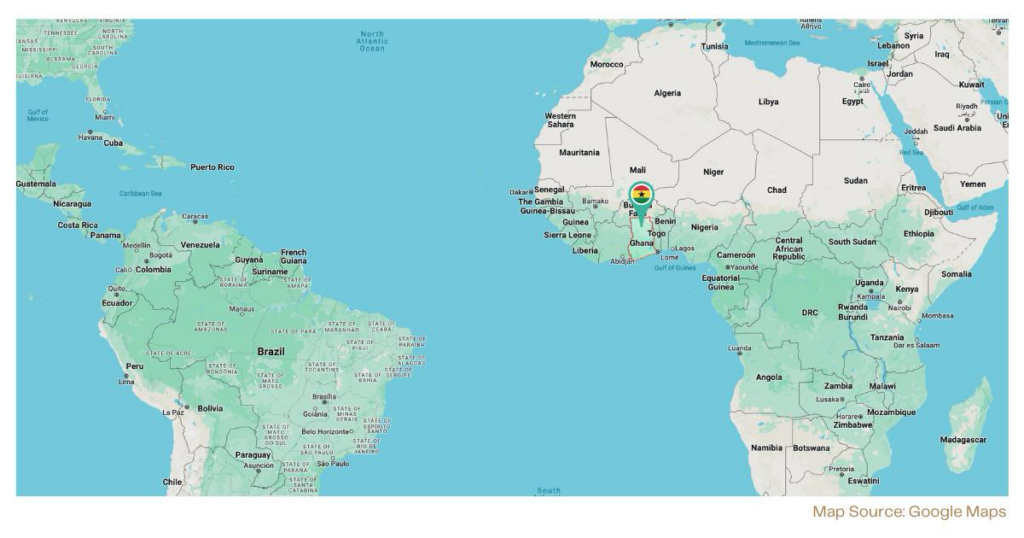Traveling to Ghana is a feast for the eyes in every way – from the natural beauty that surrounds you as well as the tantalizing dishes at mealtimes! The scent of spices and stews in the air will have your mouth watering. Ghanaians source their proteins from the land and sea and add to it a diverse range of vegetables and grains.
The traditional dishes offer a range of spicy, savory, sour and sweet flavors combined with soft, chewy and sometimes crunchy textures. The combinations of ingredients delight anyone venturing to try out this cuisine.
Tasting local food gives travelers a multi-sensory experience. Through your eyes, you see the colors, shapes, & size. Through your nose, you smell the spices and the marriage of flavors coming together. Through your skin, you feel the heat from the pepper or perhaps the kitchen or the street side market stoves.
Since traditional foods are eaten with your hands, the tactile sensation enhances the experience further, especially when eating fufu, banku or jollof rice. Not a fan of eating with your fingers? Don’t worry, both local and modern restaurants have forks, spoons and knives, too!
Do you know what fufu, banku, or jollof rice are?
Read on and get a well-rounded understanding of ingredients, cooking methods and names of dishes, so not only will you be well-armed with knowledge, but your taste buds may actually direct your fingers to book a trip to Ghana!
What types of meat and fish proteins are present in traditional food in Ghana?
Beef, pork, lamb, goat, chicken, smoked turkey and fish are the typical animal proteins. Among the fish, tilapia is plentiful along with local herring and anchovy. And let’s not forget about octopus and prawns in the seafood category. While fish is the most abundant animal protein, chicken is the most popular.
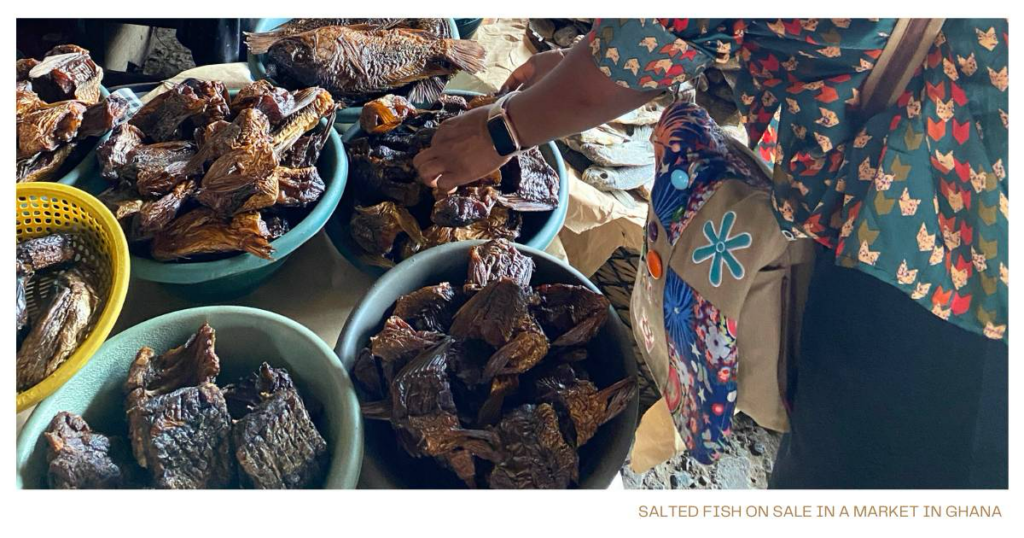
Were you expecting the Ghanaian diet to be a bit more…exotic?
Look no further, because for those with an adventurous palate, there are game meats (e.g. Antelope), reptiles (e.g. monitor lizard or snake.).
If you are quite daring, you may want to try snails, crickets, African palm weevil and other insects, which are eaten in specific regions of the country.
Although most restaurants will serve the types of meats and fish that we are accustomed to, moving away from the capital and into the countryside may give you the opportunity to try bush meat. We would advise you to be cautious, and though you are adventurous, to keep in mind that there are high risks involved in consuming these sources of protein. These risks are health based, as such meats may lead to the transmission of infectious and deadly diseases and in certain areas some of the meat may come from animals that have been poisoned.
What vegetables, fruits, grains & spices are used in Traditional Ghanaian Cuisine?
Basmati & jasmine rice as well as cassava, yam, and corn are the country’s main starches. Black eyed peas are present in many dishes and offer starchiness and a decent load of protein and fiber to make it a healthy staple of the Ghanaian diet.
Aromatics like onion, bell peppers, garlic, ginger, chili peppers, and peppercorn are used to add flavor. Bay leaves, allspice, curry and thyme add depth to the recipes. Tomato is used heavily for color, acidity, and water content to round out stews, mains, and sides.
Other vegetables included in the diet are eggplant, garden eggs (varieties of small eggplant with different colored whitish or yellowish skin), okra, peas and cocoyam and cocoyam leaves. Cocoyam, better known as taro in the US, is a type of tuber or root. Jute mallow leaves and young fruit are also used in some traditional dishes, providing a good dose of fiber and vitamins and minerals such as vitamins A and C, potassium, magnesium, and calcium.
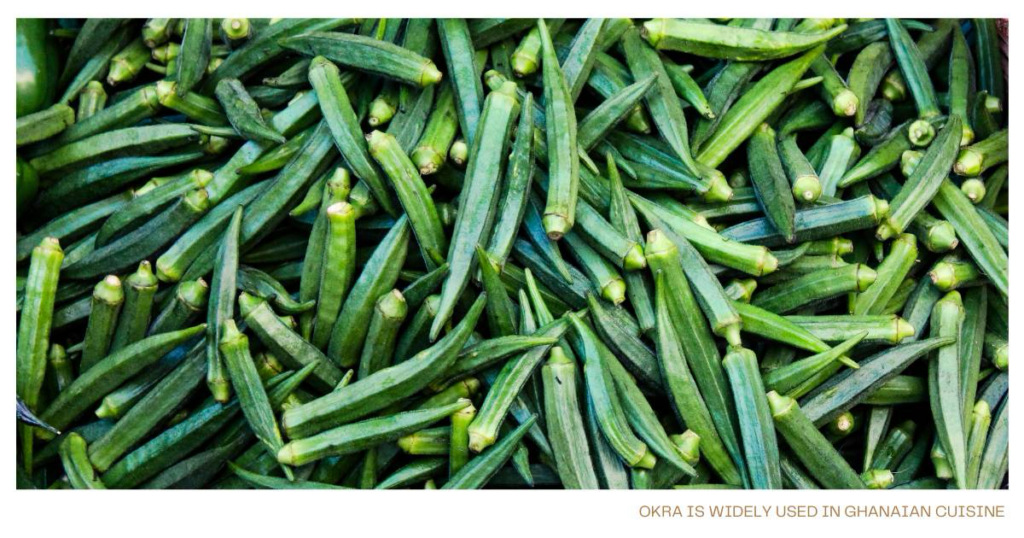
Bananas and plantain are often fried and served with a meal. If you have not tried fried plantains or bananas, you are missing out! When done right, it is soft, sweet, and tender on the inside and crip and caramelized on the outside! Papaya, pineapple and mango are eaten as dessert, while peanuts are a common snack. Peanuts are also prepared into soup or a dessert.
On that note: People with peanut allergies should advise restaurants and hotels. They are used quite extensively when preparing food in Ghana
An education on yams: A staple traditional food in Ghana
Now comes the low-down on yams that you definitely need to have!
You know how we use the words yams and sweet potatoes interchangeably in the US? We´re wrong! They are two different things, my friend.
A sweet potato is orange, sweet and soft when cooked. The one we put in sweet potato pie. Yams are something else!
I know, I thought the same way until I traveled to Africa!
Yams have tough brown skin, and pale-yellow insides. The texture is drier and more fibrous than that of a sweet potato. Most would say that yams are very mildly sweet to not sweet at all. The flavor and texture remind you of a white potato but with a little stronger flavor.
Yams and sweet potatoes originate in completely distinct parts of the world, too! Yams are native to Africa and Asia, while sweet potatoes are native to South America.
And since yams are a staple of Ghana, trust me, they know how to cook it right and make it delicious! You won’t miss the orange stuff!
What are the Most Popular and “Must Try” Dishes in Ghana?
Ghanaian cuisine includes many dishes, both sweet and savory, that will be enjoyed by a more Western palate. Here I have categorized them according to the time of day they are eaten.
First up: A Ghanaian Breakfast- the “most important meal of the day!”
Ghanaian urbanites may opt for a “modern” breakfast of coffee or tea with bread as they head out the door, but folks out in the country and manual workers, needing a more “stick to your ribs” kind of breakfast lean toward the traditional fare of Waakye, Oblayo, Hausa Koko with Koose, or Bofrot and yogurt, the poor man’s breakfast.
Oblayo (Hominy Corn Porridge) is a traditional Ghanaian dish made from using dried corn kernels that have been soaked in water and cooked into a porridge-like consistency. Oblayo is typically flavored with spices like cinnamon, nutmeg, or ginger, and sweetened with sugar or sweeteners like condensed milk to enhance its taste.Waakye, pronounced “waachey” is a hearty, savory dish made with rice and black-eyed peas or red beans. This rice-bean mixture is the heart of waakey, but these days it is often accompanied by spaghetti, salad, meat and/or fish, egg and shito, the famous spicy sauce eaten at many or all meals.
Sometimes “garri” is added to the morning plate of goodies for extra texture. Garri is a grated, slightly fermented and roasted cassava side dish. The final taste and texture being crispy, slightly sour granules of delight.
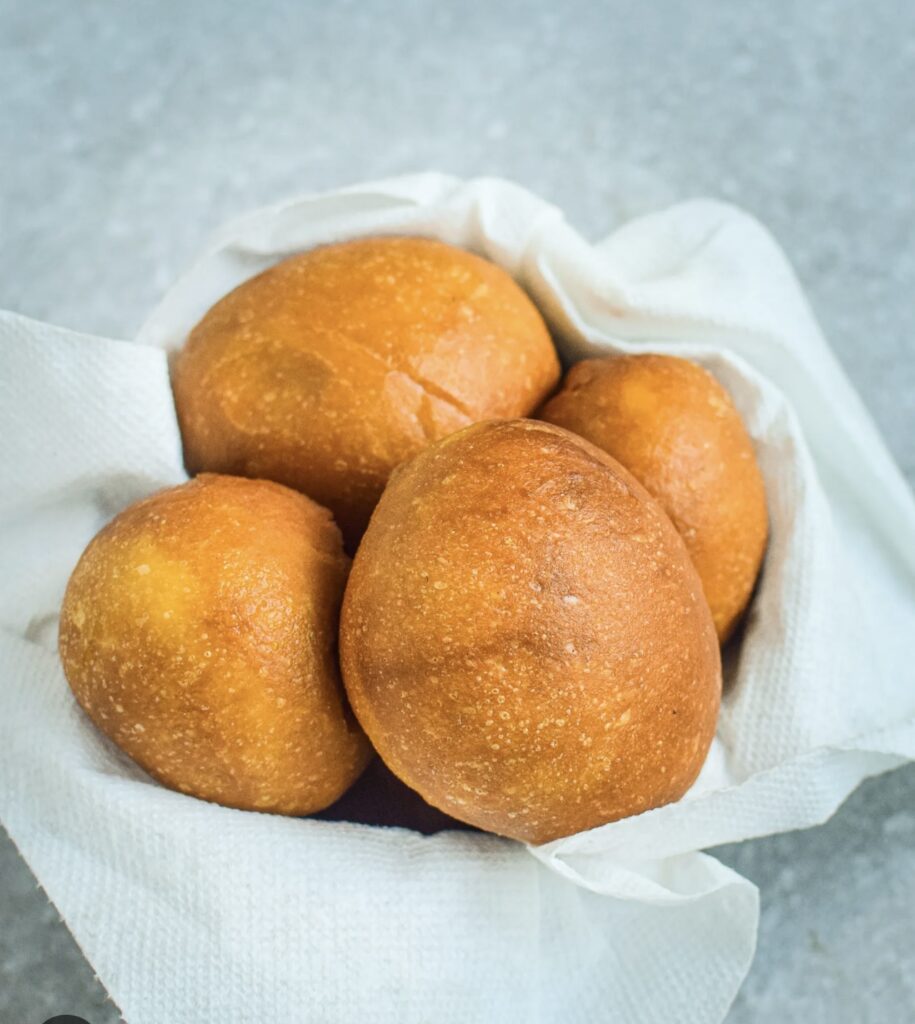
Bofrot (Puff Puff), is a deep-fried doughnut-like pastry with a slightly crunchy exterior and a soft, fluffy interior, often enjoyed as the first meal of the day or a sweet treat at any other time.
Hausa Koko is a spicy millet porridge, paired with Koose, a bean cake or fritter, usually served together in the morning.
Koko with Koose (Cornmeal porridge and bean cake/bread): Koose, or bean fritters, are deep-fried bean cakes often enjoyed with Koko, a spicy cornmeal porridge, as a breakfast or snack.
Rice Water is a rice porridge often sweetened with milk, cinnamon and sugar. Sometimes it is eaten simply with a little salt.
Tom Brown, a smooth, creamy porridge, is made from a blend of roasted corn, millet, and groundnuts (peanuts) and cooked with water or milk. The grains are toasted and ground into a fine powder before cooking. It is sweetened with sugar or honey and with spices like cinnamon or nutmeg.
Any of these will give you a tasty start to the day, and as you have seen, some serve as a delicious “pick-me-up” during a day exploring this amazing country.
Next Up: What can you expect at Lunch and Dinner meals in Ghana? Main Dishes!
After all that sightseeing and hiking, you’ve surely worked up an appetite!
Before getting into the dishes, you need to know that cassava or yam, in some form, are often served in a soup or stew. Sometimes they are served on the side, where you tear off pieces and dip it into your soup or stew. At other times, they are eaten with cocoyam leaves and shito, which is the famous chili sauce known to be in every restaurant and household in Ghana.
The meats, if added, are cooked/steamed separately and then added to the soups and sometimes dried fish or meats are added to soups and stews during the cooking process to add flavor from the get-go. Either way, the flavors come together to dance on the palate and bring you nothing but joy!
A few traditional dishes go through a fermentation process, which gives the final product a bit of a sour taste. Most countries around the world have some sort of fermented food as part of their tradition and the fermentation process mentioned here adds important probiotics to the Ghanaian diet!
7 delicious dishes in Ghanaian Cuisine to get you started on your culinary journey!
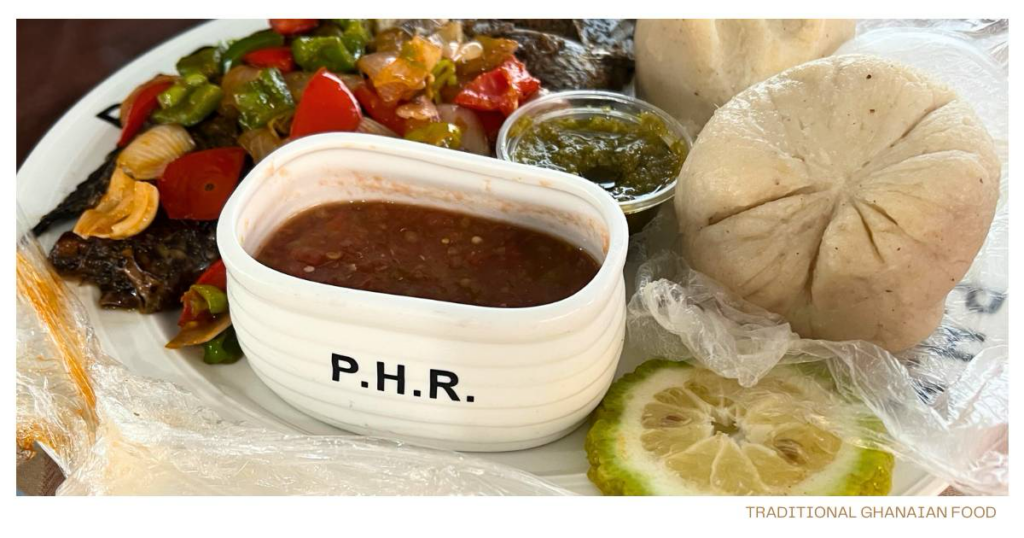
- Fufu: A staple in Ghanaian cuisine, Fufu is a dough-like dish made from pounded cassava, yams, or plantains, often combined with cocoyam. It’s typically served with aromatic soups or stews and is enjoyed for its smooth texture and its ability to soak up flavorful sauces. In the photograph above, Fufu is the ball of dough-like substance you see. It is often wrapped in cling film to keep it moist and fresh.
- Jollof Rice: A vibrant and popular dish across West Africa, Jollof Rice is a one-pot dish made with rice, tomatoes, onions, and a blend of spices such as thyme and curry. It’s known for its rich reddish-orange color and savory flavor, often accompanied by meats or vegetables.
- Ghanaian Red Red: A delightful dish featuring fried ripe plantains served with a savory bean stew. The plantains are fried to golden perfection and paired with a flavorful bean sauce, usually cooked with onions, tomatoes, and spices, offering a sweet and savory combination.
- Kelewele: A beloved Ghanaian street food, Kelewele consists of spicy, cubed plantains seasoned with a blend of ginger, pepper, and spices, then deep-fried until crispy on the outside and soft inside, creating a delicious sweet and spicy flavor.
- Kenkey: A fermented cornmeal dish wrapped in plantain leaves and steamed, Kenkey has a sour taste and a dense, dough-like texture. It is often enjoyed with soups, stews, or fish.
- Banku with Tilapia: A traditional dish combining fermented corn and cassava dough, Banku is commonly served with grilled or fried tilapia fish. The dish offers a unique blend of flavors and textures, complemented by the spicy and tangy taste of fish.
- Shito (Hot Pepper Sauce): A spicy and aromatic black pepper sauce made from a blend of hot peppers, fish, shrimp, onions, and spices, adding a fiery kick to various dishes.
Wrapping up your introduction to traditional Ghanaian dishes
You should now have a good overview of the food in Ghana. What would you like to try first?
On the Mind, Body and Soul Tour in July 2024, I have planned an itinerary that gives you the opportunity to try some of the Ghanaian Cuisine safely. Having visited Ghana several times, I worked with our tour guide host and partner to curate a list of the best places to eat and we’re looking forward to welcoming you and seeing the look on your face when you first try some of the local dishes!
Would you like to know more?
Check Out Our Exciting Tour To Ghana!
Additional resources:
Learn more about yams and how to cook them:
Become more informed about bushmeat consumption in Ghana: Take a peek at some of the top restaurants in the capital Accra:
[/vc_column_text][/vc_column][/vc_row]

